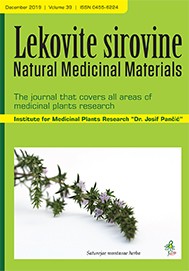Faculty of Medicine, University of Novi Sad , Novi Sad , Serbia
University of Novi Sad , Novi Sad , Serbia
Institute of Field and Vegetable Crops , Novi Sad , Serbia
Department of Field and Vegetable Crops, Faculty of Agriculture, University of Novi Sad , Novi Sad , Serbia
Department of Agronomy, Biotechnical faculty, University of Ljubljana , Ljubljana , Slovenia
Institute of Food Technology , Novi Sad , Serbia
Institute of Food Technology , Novi Sad , Serbia
The aim of this study was to characterize volatile and non-volatile compounds of rosemary from the North Adriatic region and to determine its antiproliferative activity, alone or in combination with radiomimetic bleomycin (BLM) on three malignant and one non-transformed human cell line. Chemical analysis of the volatile compounds revealed the presence of monoterpenes (93.8%), in which 1.8-cineol (32.9%) and camphor (15.5%) were the dominant compounds. Also, obtained results showed that the major polyphenolic constituents in rosemary extract were phenolic acids (rosmarinic acid and its derivatives up to 69.2 mg 100 g-1), as well as flavones and flavonols in the following order: luteolin>isorhamnetin>quercetin>kaempferol>apigenin. Cell growth test showed that rosemary extract alone exerted moderate antiproliferative activity, as well as a synergistic antiproliferative effect with bleomycin (EC50 344.3-461.5 µg mL-1 and 58.6-292 µg mL-1, respectively). The anti-tumor effect of rosemary extract in combination with BLM was much stronger, compared to BLM itself on the breast cancer cells. Through their proposed sensitizing effect, rosemary extracts, in combination with the standard chemotherapeutics, could be used for the investigations of possible therapeutic modalities.
This is an open access article distributed under the Creative Commons Attribution License which permits unrestricted use, distribution, and reproduction in any medium, provided the original work is properly cited.

The statements, opinions and data contained in the journal are solely those of the individual authors and contributors and not of the publisher and the editor(s). We stay neutral with regard to jurisdictional claims in published maps and institutional affiliations.